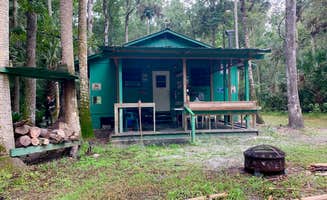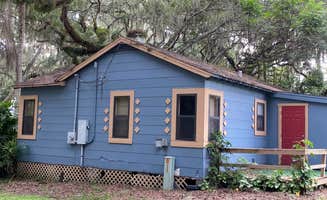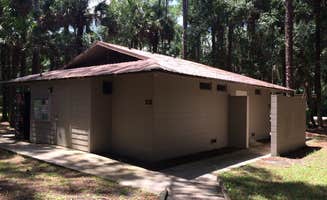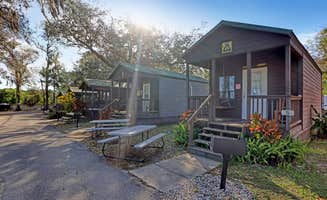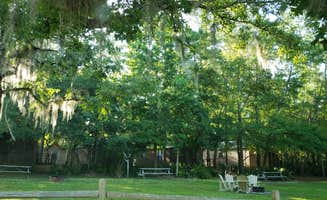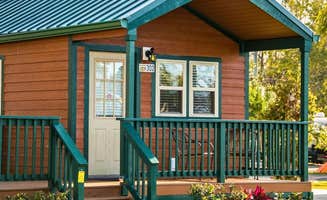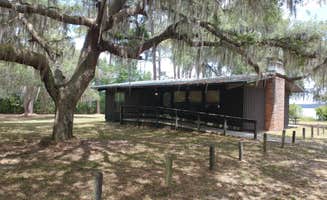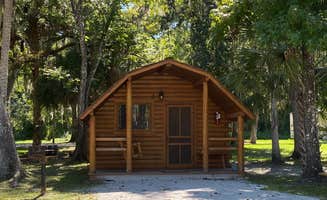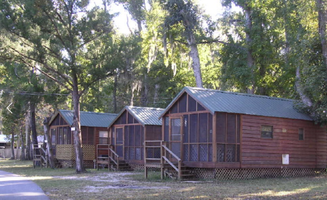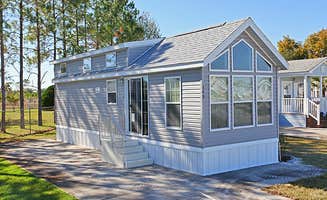Cabin camping near Winter Springs, Florida provides convenient access to natural springs and state park amenities within a 30-mile radius. The area sits at approximately 45 feet above sea level with subtropical climate conditions that allow for year-round camping opportunities. Winter months (November-February) typically offer the most comfortable temperatures for outdoor activities with average highs around 70-75°F.
What to do
Spring swimming access: 1 mile walk from camping area at Wekiwa Springs State Park Campground requires early arrival during peak season. According to one visitor, "We camped for three nights and loved it! Yes it rained most of the time but our site never flooded!! Such a nice view of the sunset from where we were. Saw lost of animals."
Kayaking wildlife viewing: Multiple launch points at Blue Spring State Park Campground where you can observe manatees during winter months. "We spent much of our time kayaking from the park's canoe launch. Here, we were able to see tons of wildlife from all sorts of fish, alligators, and yes, a manatee!" notes a camper.
Bike trails: Paved and off-road options available throughout many parks. At Lake Louisa State Park, "The winding roadways within the park offer great bicycling opportunities" and "This park is one of our many Trifecta parks, meaning we can hike, bike and kayak."
Fishing access: Multiple lakes and ponds within short distances of campsites. Some parks offer rental equipment. "Fishing piers at both Dixie and Hammond Lake. You can also fish and boat on Lake Louisa too."
What campers like
Privacy between sites: Many cabins offer vegetation barriers for seclusion. At Wekiva Falls RV Resort, "The campgrounds are very well kept with a fair bit of space and foliage between sites for privacy. Love this place!"
Family-friendly water features: Natural springs and constructed swimming areas appeal to all ages. "The spring is awesome. Really enjoyed the springs and kayaking. The camp site was nice with a pit and grill on site," shares a visitor to Blue Spring State Park.
Wildlife viewing opportunities: Early morning and evening hours best for spotting native species. "We were serenaded by the cackle of wild turkey, the squeals of wild pig, the yip and yap of coyotes, hoots from resident owls and the occasional shrill from the bobcat."
Clean facilities: Most cabin locations maintain modern bathhouses with regular cleaning. One Kelly Park Campground visitor noted, "The bath house is very nice and clean. The sites are all pretty much shaded. There are some swings and a cleared area the kids ran around/played chase right in front of the bath house."
What you should know
Reservation windows: Most popular cabin sites book 6+ months in advance, especially for winter season. Prepare to reserve immediately when windows open.
Varying amenity levels: Basic to deluxe cabins differ significantly in what's provided. At Disney's Fort Wilderness Resort & Campground, "They offer everything!" while more rustic parks provide minimal amenities.
Noise considerations: Some cabin locations experience transportation noise. One camper noted, "The only drawback I found from the campsite/campground area was the noise. There are train tracks near the state park, so hearing trains throughout the night (especially at 3am) was not what I'm looking for when I get out into nature. So bring ear plugs!"
Seasonal staffing levels: Services and maintenance can vary during off-peak times. "The staff is actually out and present around the campground. All are extremely friendly and helpful. The campground is very clean and tidy."
Tips for camping with families
Pack entertainment for rainy days: Florida afternoon thunderstorms common May-September. "We camped for three nights and loved it! Yes it rained most of the time but our site never flooded!!"
Arrive early for water activities: Springs and pools reach capacity by mid-morning, especially weekends. A camper at Bill Frederick Park at Turkey Lake explains, "This park is awesome. Really enjoyed the springs and kayaking... Only complaint I have was that we're near the airport and heard a lot of planes flying by overnight."
Consider cabin locations carefully: Distance from facilities matters with small children. "We were walking distance to the pool, arcade, trading post, and campfire/sing along. There were about 20 rv/camping spots in our loop."
Kitchen planning essential: Cabin cooking facilities vary dramatically between locations. "Most cabins include beds but require visitors to bring their own linens, towels, and toiletries. Basic cabins typically offer minimal kitchen facilities."
Tips from RVers
Leveling challenges: Some cabin areas share parking with RV sites requiring equipment. "Holy moly did it take a lot to get this into our spot. Our neighbor across from us had to move his truck and several neighbors were helping direct us into our spot."
Water pressure variations: Bring regulators for hookup sites to prevent hose damage. "We had a issues with our water a few days ago, so we had to use the shower at the facility and it was good."
Power considerations: Limited outlets in rustic cabins may require extension cords. "The only drawback was that the power went out on our last of 7 days and that was all we could take. We left a night early as no power, no water and 95 degrees in Late May did us in."
Road navigation inside parks: Internal roads often narrow with tight turns. "Paved loop, clear sites, close to stores, restaurants, and the spring. Kayaked the river, and even swam with manatees in the spring!!!"


